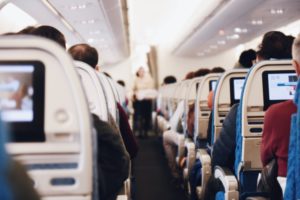Why is it important?
Business air travel is one of the greatest contributors to an organisation’s carbon footprint. These travels by plane have a carbon footprint that needs to be reduced across institutions, and where indispensable, they must conform to sustainable travel norms.
What is the solution?
If a flight is unavoidable, more fuel-efficient journeys must be preferred. Great reductions to carbon emissions can be achieved by choosing direct flights over connecting flights, as they offer a shorter route and save fuel on landing/take-off cycles. Direct flights also provide a more direct flight path, with no unnecessary detours. A study conducted in the United States found that 40% of the reduction is due to shorter routes and 60% accounts for the landing and take-off cycle.(1) The ‘Direct flights only’ solution is relatively easy to implement and benefits the staff that travels. It is easily measurable, reportable, and verifiable.
Point of attention
-
Point of attention
Direct flights refer to non-stop flights only – stopovers use more fuel even if the passenger stays in the same plane.
Key actions
-
#1 Create a direct flight priority rule
Update or create the organisation’s travel and expense policy and include a direct flight priority rule (where direct flights exist) for all airline tickets. Connect with the travel agency to implement this rule for all travel bookings.
-
#2 Exceptions should be rare
Only make exceptions for flights which present extreme cost differences, and for itineraries where direct flights are not offered.
-
#3 Decision making for extreme costs
Create a decision tool that establishes acceptable additional costs for direct flights. This can be based on a percentage of the baseline cost (25% additional cost, for example) or on a fixed amount.
-
#4 Quantify the gains
Quantify the gains achieved, through a carbon tracker tool, for example.
-
#5 Mitigate costs
The organisation must also recognise and accept that some extra cost may occur. Good planning is essential to book flights early and save on plane ticket costs. Include a policy that requires employees to book their flight within 10 days of receiving their travel assignment, for example.
-
#6 Communicate and raise employees’ awareness
Raise employees’ awareness on the importance of direct flights. The success of the policy depends on the staff’s understanding and participation, as they often book their own flights.
To consider
-
Potential co-benefits
- Reduction of travel time
- Employees being more rested when arriving at their destination
- No baggage transfer needed
- Reduced risk of missing a connecting flight
- Reduced hotel costs associated with long transfers (scheduled or due to delays)
- Reduction of air and noise pollution
-
Success conditions
- Staff awareness raising about the importance of direct flights
- Involve the organisation’s leaders in the decision-making process to ensure their acceptability
- Book flights in advance in order to mitigate costs
-
Prerequisites & specificities
- To implement this solution, the organisation’s travel policy must be adjusted along with the travel booking tool
-
Potential risks
- Direct flights can be more expensive
Tools and good practices
-
Stay Grounded Travel Policy Guide
Multiple guides for organisations who wish to reduce the climate impact of their air travel.
Explore here -
Stay Grounded Community of Grounded Organisations
List of organisations that have pledged to reduce their emissions related to air travel through their partnership with Stay Grounded.
Explore here
To go further
-
Aviation Carbon Emissions, Route Choice and Tourist Destinations: Are non-stop routes a remedy? 2019
This paper analyses whether non-stop flights to tourist destinations reduce air travel emissions compared to connecting flights, finding that direct routes typically emit about 100 kg less CO₂ per person on average.
Explore here -
Is there a sustainable way to fly, 2021
This Independent article discusses the different ways in which individuals and businesses can reduce their emissions related to air travel.
Explore here
Professional travel

Transport

Sources
(1) K.D. Debbage and N. Debbage, ‘Aviation carbon emissions, route choice and tourist destinations: Are non-stop routes a remedy?’, Annals of Tourism Research, 2019, Available here, (accessed 29 July 2025).
(2) H. Tuppen, ‘Is there a sustainable way to fly?’, Independent, 2021, Available here, (accessed 29 July 2025).
(3) ICAO, ‘Carbon Emissions Calculator’, Available here, (accessed 29 July 2025).
(4) Stay Grounded, ‘Community of Grounded Organisations‘, Stay Grounded, Available here, (accessed 29 July 2025).
Acknowledgements
Last updated 30 October 2025
Share your success stories, suggestions, and comments with us! contact@climateactionaccelerator.org
Cover photo © William Bayreuther/Unsplash.
